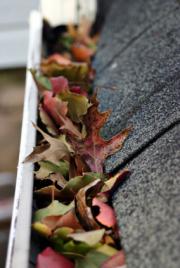Simple Summer Tasks
Whether you’re cooling off indoors or working on your tan, take the time to perform some simple, routine home maintenance. Rising temperatures and sunny days make summer an ideal season for getting work done around the house. You’ll have a safer home if you catch problems and wear-and-tear before they become hazards.
Keeping Cool Inside
Energy efficiency is a top priority when electricity bills climb as high as the temperatures outside. Hopefully you’ve had your air conditioning system checked in the spring, as repairmen are often busy in the summer and you may have to sweat it out until your appointment.
Ceiling fans provide an energy-efficient way of circulating cool air. Dust them if needed and balance any wobbly blades by tightening loose screws. For additional energy efficiency, check windows and doors for air leaks and seal with weather stripping or caulk as needed. You’re paying for the cool air, so take steps to be sure it’s not escaping outdoors.
Home Exterior Care and Landscaping
Take advantage of the warm weather and wash the outside of your windows and clean the siding. While it might be tempting to use a pressure washer, a garden hose is best to avoid potentially damaging the exterior of your home. Apply a coat of fresh paint if needed, and repair any damaged vinyl or aluminum siding.
Be aware of termites while you’re outside inspecting your home. Termites can easily go undetected until significant damage has been done. Look for telltale signs like flaking wood or mud buildup and tunneling systems in the exterior wood of your home. Professional pest control inspections are recommended if you have any suspicions of possible infestation.
Well-tended landscaping and a trim and tidy house are as welcoming to guests as the smells of a barbeque. Garden beds look their best when mulched and weeded. Summer annuals can be induced to produce more flowers and bloom longer when you deadhead them. Removing spent flowers also prevents the plant from going to seed. Check garden plants, trees, and shrubs for insect infestations. Unhealthy plants should be removed so that others may thrive.
Lush green grass is of course desirable; however, it is not always realistic or water-efficient. Encourage healthy grass growth with regular mowing, but remember: Keeping grass cut longer in the summer months will prevent roots from drying out as quickly.
Grass and plants should be watered in the morning to allow the water to soak through the soil throughout the day in order to completely nourish their root systems. Check to see if your municipality has water conservation restrictions before watering your lawn or garden.
Trees provide shady ambience and should be well cared for to avoid potential damage to your home. Keep their branches pruned and at a safe distance from your home to avoid storm-related damage. Inspect trees for signs of decay, such as cracks or hollowed limbs, and keep branches clear of your home and power lines. Arborists or tree care professionals can assist with the cutting and removal of large or high limbs.
Also, before planting additional trees and shrubs in your yard, take into consideration the plant’s size when mature and whether or not roots might intrude upon underground pipes or paved surfaces such as sidewalks and driveways.
Garage Upkeep
Hazardous materials such as paint and solvents should be disposed of properly. Don’t store heat-sensitive or combustible materials in the garage, as the temperature will be rising throughout the season. Inspect the floor for grease spots from leaking car fluids, and have your car serviced promptly if you find any.
If you have children, instruct them not to go in the garage unaccompanied. Store your hand tools and power tools behind a lock and key. Fertilizers, weed-killers, and pesticides should be stored out of a child’s reach or behind a locked cabinet. You might also consider organic gardening, which employs nontoxic alternatives to these poisonous chemicals.
Driveways And Walkways
Inspect the pavement for cracks and holes, and remedy them. This goes a long way in preventing accidental slips, trips, and falls. It also works to avoid larger repairs or resurfacing in the future. If you see weeds popping up between cracks in the pavement, resist the urge to pull them up. You’ll remove the upper part of the weed, but the root system will remain intact and new growth will return within a few weeks. For a cost-effective and chemical free solution, boil water in a kettle, carefully carry the kettle outside, and pour the water on any weeds to kill them off for the season.

 Lubricate locks and hinges: Creaky hinges and sticking locks can spook you at exactly the wrong moment, so make the rounds with a can of WD-40. It’ll clean and lubricate metal mechanisms in one shot.
Lubricate locks and hinges: Creaky hinges and sticking locks can spook you at exactly the wrong moment, so make the rounds with a can of WD-40. It’ll clean and lubricate metal mechanisms in one shot. Quiet kitchen cabinets: Before the Fall is over, your kitchen will soon be bustling with holiday dinners, baking projects, and house guests, so don’t let little annoyances get in the way of big plans. Clean and lubricate drawers and hinges on kitchen cabinets, and replace any catches that no longer catch.
Quiet kitchen cabinets: Before the Fall is over, your kitchen will soon be bustling with holiday dinners, baking projects, and house guests, so don’t let little annoyances get in the way of big plans. Clean and lubricate drawers and hinges on kitchen cabinets, and replace any catches that no longer catch.